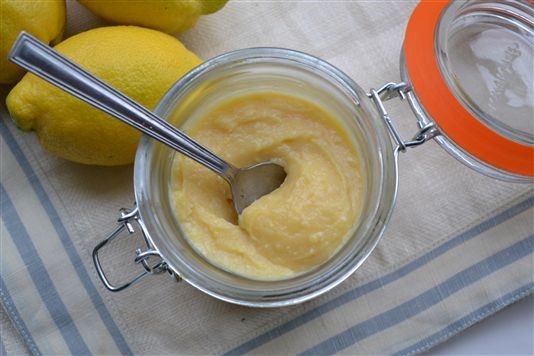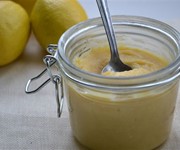Make it don't buy it: lemon curd

Lemon curd is a curious thing. It’s kept in jars and sold in the jam aisle of the supermarket. Yet technically, lemon curd is more of a thick custard than a traditional preserve. It became popular in the late 19th Century and we think homemade curd is due a comeback.
Romans and Crusaders
Lemons are believed to be native to India or Malaysia. They were first introduced to Europe by the Romans, and the Crusaders also brought lemons from Palestine to Spain and Italy. The word ‘lemon’ first came into use around 1350, a Middle English adaptation of the French ‘limon’ which suggests lemons reached Britain via France. However, it wasn’t until the 15th century that they became widely cultivated in southern Europe and used as an ingredient.
The earliest recipes for lemon curd call it ‘lemon cheese’ – the first mention of ‘lemon curd’ was in 1844, in The Lady’s Own History Book, according to British Food History. Although the recipe was rather different from what we now know as lemon curd - using lemons to help separate curds from whey. Lemon curd as we know it became popular towards the end of the 19th Century. The Victorians and Edwardians were partial to lemon curd spread on crumpets, scones or bread at afternoon tea. It was also traditionally used as a tartlet filling.
Post-war popularity
Lemon curd was a rarity during the Second World War, as lemons were unavailable in Britain: “men in the forces serving in Italy or Sicily would sometimes send a few home,” says Jane Fearnley-Whittingstall (Hugh’s mum) in The Ministry of Food. As lemon curd’s other ingredients, butter, eggs and sugar, were also rationed, the halcyon days of lemon curd on scones at afternoon tea must’ve seemed a distant memory.
The 60s and 70s saw lemon meringue pie become a voguish dessert in Britain. This pudding with its lemon curd-style filling and meringue top has roots which go back centuries, but may have become fashionable once more after Brits got a taste for similar American import ‘Key lime pie’. In a memorable passage in his memoir Toast, Nigel Slater works out his stepmother’s secret lemon meringue pie recipe by monitoring the amount of egg shells and lemon skins he finds in the bin.
Make it Don’t Buy It
 The British food revival of the 90s and noughties has seen a modest lemon curd resurgence, with upscale brands such as Duchy Originals offering their own versions. But as long as you don’t mind a little whisking and stirring, homemade lemon curd tastes so much nicer. Plus you probably have most of the ingredients already.
The British food revival of the 90s and noughties has seen a modest lemon curd resurgence, with upscale brands such as Duchy Originals offering their own versions. But as long as you don’t mind a little whisking and stirring, homemade lemon curd tastes so much nicer. Plus you probably have most of the ingredients already.
Makes enough for a ½ litre jar.
Ingredients
- 4 large eggs
- 2 large egg yolks
- 175 g golden caster sugar
- 1 pinch salt
- 3 lemons, juice only
- 2 unwaxed lemons, finely grated zest only
- 100 g unsalted butter
- 4 large eggs
- 2 large egg yolks
- 6.2 oz golden caster sugar
- 1 pinch salt
- 3 lemons, juice only
- 2 unwaxed lemons, finely grated zest only
- 3.5 oz unsalted butter
- 4 large eggs
- 2 large egg yolks
- 6.2 oz golden caster sugar
- 1 pinch salt
- 3 lemons, juice only
- 2 unwaxed lemons, finely grated zest only
- 3.5 oz unsalted butter
Details
- Cuisine: English
- Recipe Type: spread
- Difficulty: Easy
- Preparation Time: 10 mins
- Cooking Time: 15 mins
- Serves: 6
Step-by-step
- Beat the egg yolks and eggs together in a large bowl and put to one side.
- Half fill a large saucepan with water and bring to a simmer. Place a glass bowl over the top of the pan, ensuring it doesn’t touch the water. Add the butter to the glass bowl and stir for 2 minutes, or until it starts to melt.
- Add the lemon zest, juice, sugar and salt. Keep stirring constantly until butter has melted and sugar has dissolved. Strain through a sieve into another pot or large bowl. Discard the lemon zest and return the smooth liquid mixture to the glass bowl over the simmering water.
- Remove the bowl from the heat and pour in the egg mixture, whisking constantly to combine. Return to the heat and stir or whisk for around 10-15 minutes until the mixture has thickened to a custard-like texture and sticks to the back of the spoon.
- Remove from the heat and sieve again. Leave to cool and then pour into a sterilised jar and seal. Store in the fridge and use within one week.
You might also like
Comments
Be the first to comment
Do you want to comment on this article? You need to be signed in for this feature